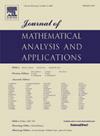Investigation on stochasticity-induced persistence
IF 1.2
3区 数学
Q1 MATHEMATICS
Journal of Mathematical Analysis and Applications
Pub Date : 2025-05-07
DOI:10.1016/j.jmaa.2025.129629
引用次数: 0
Abstract
The spread of epidemics is inevitably influenced by a wide range of random factors, resulting in complex and diverse dynamics. This study develops a stochastic epidemic model driven by the Black-Karasinski process to investigate the impact of environmental noise on disease extinction and uniform persistence. Two key quantities are formulated to characterize the conditions for disease persistence and extinction, with rigorous analysis of their relationship. Sufficient conditions for the existence of a stationary distribution and disease extinction are established. Additionally, an optimal control problem is proposed for the stochastic model to achieve a dynamic balance between disease control and socio-economic requirements, with the optimal control derived. Notably, our findings reveal that the persistence-determining quantity for the stochastic system is higher than the basic reproduction number of the deterministic system. Most intriguingly, we find that noise favors to the persistence of the disease. Such a stochasticity-induced persistence effect challenges the conventional conclusion that large noise suppresses disease prevalence. Numerical studies further examine the effect of random factors on the quantities and the dynamic behavior especially when unity is between the two quantities. Additionally, the effect of noise intensity on extinction probability and the noise distributions associated with the transition from extinction to persistence is explored through numerical simulations.
随机诱导持久性的研究
流行病的传播不可避免地受到各种随机因素的影响,形成复杂多样的动态。本文建立了一个由Black-Karasinski过程驱动的随机流行病模型,以研究环境噪声对疾病灭绝和均匀持续的影响。制定了两个关键数量来表征疾病持续和灭绝的条件,并严格分析了它们之间的关系。建立了稳态分布存在和疾病灭绝的充分条件。在此基础上,提出了随机模型的最优控制问题,以实现疾病控制与社会经济需求之间的动态平衡,并推导出最优控制。值得注意的是,我们的研究结果表明,随机系统的持续决定量高于确定性系统的基本再现数。最有趣的是,我们发现噪音有利于疾病的持续存在。这种随机诱导的持久性效应挑战了大噪声抑制疾病流行的传统结论。数值研究进一步考察了随机因素对数量和动态行为的影响,特别是当两个数量一致时。此外,通过数值模拟探讨了噪声强度对消光概率的影响以及消光向持续过渡过程中的噪声分布。
本文章由计算机程序翻译,如有差异,请以英文原文为准。
求助全文
约1分钟内获得全文
求助全文
来源期刊
CiteScore
2.50
自引率
7.70%
发文量
790
审稿时长
6 months
期刊介绍:
The Journal of Mathematical Analysis and Applications presents papers that treat mathematical analysis and its numerous applications. The journal emphasizes articles devoted to the mathematical treatment of questions arising in physics, chemistry, biology, and engineering, particularly those that stress analytical aspects and novel problems and their solutions.
Papers are sought which employ one or more of the following areas of classical analysis:
• Analytic number theory
• Functional analysis and operator theory
• Real and harmonic analysis
• Complex analysis
• Numerical analysis
• Applied mathematics
• Partial differential equations
• Dynamical systems
• Control and Optimization
• Probability
• Mathematical biology
• Combinatorics
• Mathematical physics.

 求助内容:
求助内容: 应助结果提醒方式:
应助结果提醒方式:


